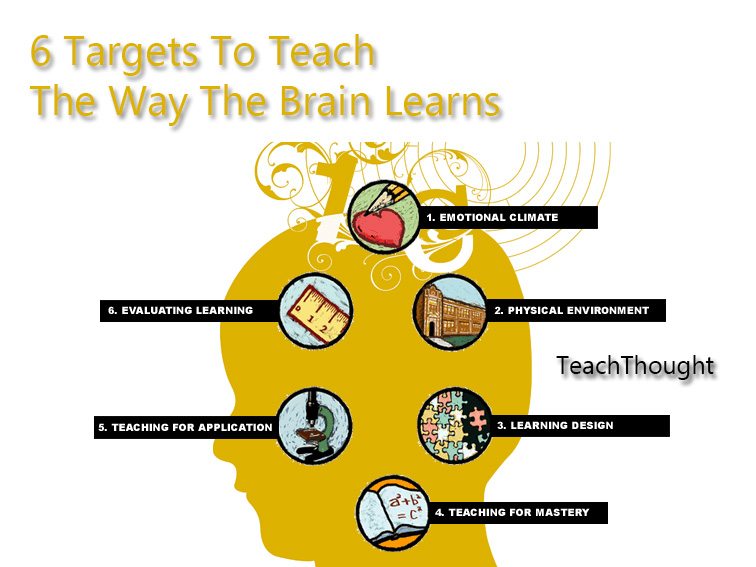
Teach The Way The Brain Learns
by Ramona Persaud
When you’re standing in front of a classroom of students who’re not quite sure they even want to be in your class, much less pay attention to what’s being said, things like neuroscience, research studies, and teaching the way the brain learns are an abstraction.
Yet, brain-targeted teaching can engage and excite students because it taps into factors that stimulate the brain, grab the attention, and set the stage for learning.
Dr. Mariale Hardiman, a former school principal, now professor at Johns Hopkins, developed a teaching framework designed to help teachers, teach the way the brain learns. Practioners of the model, Justin Holbrook, Jeremy Mettler, and Vicky Krug, describe the model as a set of guidelines to help organize material, “It gives you a way to organize the material you’re covering and to explore different ways to communicate it, explains Holbrook.
Krug continues, “Learning only occurs when the student can connect new information to old information. Teaching someone how a car works is pointless if they don’t know what a car is.”
Mettler also points out the importance of recognizing it as a non-linear process, “The components are all interrelated.”
Brain Target 1: Establish the emotional climate for learning
Neuroscience: The brain feels before it thinks. The amygdala (think fight/flight) receives stimuli 40 milliseconds before the cortex (thinking). (LeDoux, 1996).
Usable classroom translation: stress impedes learning. Try to connect with your students when they come into your class by making eye contact, greetings, and taking a moment to chat before diving into the lesson.
Brain Target 2: Creating the Physical Learning Environment
Neuroscience: The brain craves novelty. Posner & Rothbart, 2007); lighting, background noise impact on attention; the body is designed for movement (Medina, 2008)
Usable classroom translation: make regular changes in your classroom such as seating arrangements, wall displays. Inventory your learning space and note where it’s possible to modify things such as lighting, turning down speakers, etc.
Brain Target 3: Designing the Learning Experience
Neuroscience behind it: The brain looks for patterns between known and unknown information (Posner & Rothbart, 2007)
Usable classroom translation: Give students the big picture; visually represent the connections between previous knowledge and new learning; indicate relationships among learning goals.
Brain Target 4: Teaching for Mastery
Neuroscience behind it: In order for information to be retained it must make its way from short-term to long-term memory.
Usable classroom translation: Use the arts as a tool to enhance and reinforce learning goals (Rinne, Gregory, Yarmolinskaya, and Hardiman, 2011)
Brain Target 5: Teaching for the Extension
Neuroscience behind it: The brain is plastic. Significant changes occur in the brain due to repeated sensory experience (Fu & Zuo,2011, Karmarkar & Dan, 2006)
Usable classroom translation: Creativity can be taught but it builds on a body of content knowledge being mastered. Interweave information and thinking in all content areas; show real world applications, move away from simple, single-answer problems to encourage divergent solutions.
Brain Target 6: Evaluating Learning
Neuroscience behind it: Assessments provides feedback that informs and motivates students; retrieval of information recruits memory systems, reinforcing memory for that information.
Usable classroom translation: Feedback has to be useful, timely; model active retrieval – flashcards, self-quizzing (no looking at the answers), space learning, multiple types of assessments.
Further Reading & Connecting
For more information about brain targeted teaching go to braintargetedteaching.org
Check out a trailer for the documentary Grey Matters, exploring Hardiman’s model in practice, with Holbrook, Mettler, and Krug here.
This film is currently crowdfunding for postproduction funds (all donations are tax deductible).
Follow the film Grey Matters at facebook.com/greymattersdocumentary and at twitter.com/changethelens
Ramona Persaud is an independent documentary filmmaker, writer, and photographer. “Grey Matters” is her second film. Persaud’s first film, “It’s a Different World,” explores the world of autism through the eyes of three autistic children. Visit greymattersdocumentary.com for more information; 6 Targets To Teach The Way The Brain Learns
